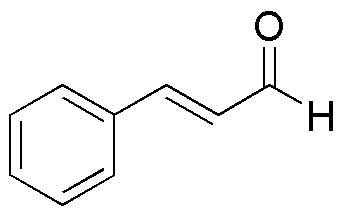Cinnamaldehyde is widely utilized in research focused on:
- Flavoring and Fragrance Industry: Commonly used as a flavoring agent in food products and as a fragrance in cosmetics and perfumes, it provides a warm, spicy aroma that enhances sensory experiences.
- Pharmaceutical Applications: Known for its potential antimicrobial and anti-inflammatory properties, it is being researched for use in developing natural preservatives and therapeutic agents.
- Aromatherapy: Utilized in essential oils, it is believed to have mood-enhancing properties, making it popular in wellness products aimed at reducing stress and anxiety.
- Natural Insect Repellent: Its effectiveness in repelling certain pests makes it a valuable ingredient in eco-friendly pest control solutions, appealing to consumers looking for sustainable options.
- Research in Cancer Treatment: Studies suggest that cinnamaldehyde may have potential anticancer properties, leading to exploration in developing new cancer therapies.
General Information
Properties
Safety and Regulations
Applications
Cinnamaldehyde is widely utilized in research focused on:
- Flavoring and Fragrance Industry: Commonly used as a flavoring agent in food products and as a fragrance in cosmetics and perfumes, it provides a warm, spicy aroma that enhances sensory experiences.
- Pharmaceutical Applications: Known for its potential antimicrobial and anti-inflammatory properties, it is being researched for use in developing natural preservatives and therapeutic agents.
- Aromatherapy: Utilized in essential oils, it is believed to have mood-enhancing properties, making it popular in wellness products aimed at reducing stress and anxiety.
- Natural Insect Repellent: Its effectiveness in repelling certain pests makes it a valuable ingredient in eco-friendly pest control solutions, appealing to consumers looking for sustainable options.
- Research in Cancer Treatment: Studies suggest that cinnamaldehyde may have potential anticancer properties, leading to exploration in developing new cancer therapies.
Documents
Safety Data Sheets (SDS)
The SDS provides comprehensive safety information on handling, storage, and disposal of the product.
Product Specification (PS)
The PS provides a comprehensive breakdown of the product’s properties, including chemical composition, physical state, purity, and storage requirements. It also details acceptable quality ranges and the product's intended applications.
Certificates of Analysis (COA)
Search for Certificates of Analysis (COA) by entering the products Lot Number. Lot and Batch Numbers can be found on a product’s label following the words ‘Lot’ or ‘Batch’.
*Catalog Number
*Lot Number
Certificates Of Origin (COO)
This COO confirms the country where the product was manufactured, and also details the materials and components used in it and whether it is derived from natural, synthetic, or other specific sources. This certificate may be required for customs, trade, and regulatory compliance.
*Catalog Number
*Lot Number
Safety Data Sheets (SDS)
The SDS provides comprehensive safety information on handling, storage, and disposal of the product.
DownloadProduct Specification (PS)
The PS provides a comprehensive breakdown of the product’s properties, including chemical composition, physical state, purity, and storage requirements. It also details acceptable quality ranges and the product's intended applications.
DownloadCertificates of Analysis (COA)
Search for Certificates of Analysis (COA) by entering the products Lot Number. Lot and Batch Numbers can be found on a product’s label following the words ‘Lot’ or ‘Batch’.
*Catalog Number
*Lot Number
Certificates Of Origin (COO)
This COO confirms the country where the product was manufactured, and also details the materials and components used in it and whether it is derived from natural, synthetic, or other specific sources. This certificate may be required for customs, trade, and regulatory compliance.


